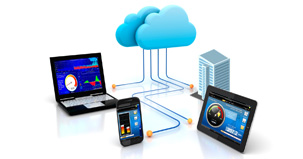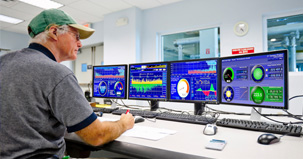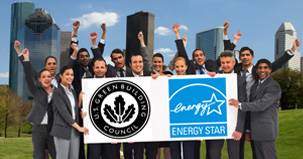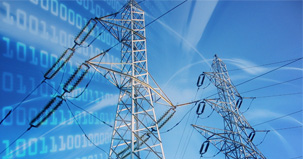- Home
- Smart Data
Smart Data
Actionable intelligence on energy and water use:
- Helps users identify inefficencies, and waste
- Provides real-time feedback on conservation
Right data for the right audience:
- Facility managers identify when and where energy is wasted
- CFO's can track and verify financial savings from initiatives
- Company knows its carbon and water footprint
Related Products
 Information any time, anywhere
Information any time, anywhere - Smart User
Smart User
Smart users leverage real-time data and reduce energy and water use by:
- Continuously identifying opportunities
- Acting on opportunities
- Tracking and verifying savings
- Sustaining savings
Related Products
 Monitor, Manage, Maintain
Monitor, Manage, Maintain - Smart Community
Smart Community
A smart community is one where all stakeholders are engaged in energy and water conservation. A smart community can be achieved by:
- Showing people precisely how much they are using
- Providing real-time feedback on conservation actions
- Effectively communicating efficiency results
Related Products
 Communicate and Conserve
Communicate and Conserve - Smart Grid
Smart Grid
Smart grid, as we define it, is a "green grid", with efficient resource use and the key to a low-carbon future. We help our customers prepare for the smart grid by:
- Engaging users with smart data
- Enabling smart users to increase resource efficiency
- Educating & empowering smart communities
Related Products
 Smart grid and a smarter future
Smart grid and a smarter future - Smart Buildings
Smart Buildings
Smart buildings maximize resource (energy, water, capital) efficiency. These buildings are optimized using energy and water management process with high data visibility which lead to reduced energy and water spending.
- Higher operating income and higher asset values for owners
- Increased productivity for occupants
- Lower carbon footprint for the community
 Resource efficient buildings
Resource efficient buildings
Recent Posts
After Certification: Monitoring Energy and Water Efficiencies
Green building rating systems, as well as professional accreditation services, are crucial tools for any company to utilize. By calling attention to potential flaws in a company’s so-called efficiency processes, such accreditation systems help companies to cut back on needlessly high utility bills. Third party confirmation of energy and water efficient practices also allows a company to advertise its operations within this framework. With the way trends are heading, such accreditation will soon be mandatory in the United States, which is even more reason to subject your company’s efficiency practices to scrutiny.
Whether certification becomes mandatory or not, there’s a real business case for attaining certification. A report released by CoStar Group, a real estate research firm based in Bethesda, Md., found that there is another reason for developers and landlords to consider adopting LEED and other certification status. “Green buildings generate 3.8 percent higher occupancy rates and are up to 30 percent more efficient,” the report claimed, noting also that green buildings command higher rent ($11.24 more) and sale prices per square foot ($171 more) than their non-certified counterparts.
How to Go Green
In the United States, the most renowned third party green building rating system is known as Leadership in Energy and Environmental Design (LEED). This system was developed by the United States Green Building Council (USGBC), and has been recognized internationally since its beginning in 1998. LEED is the chosen green building rating system for the United States and Canada, as well as several other countries throughout the world. The LEED rating system assesses everything from a building’s total water use to the quality of its indoor air, an important consideration for the health of employees. LEED has different rating systems for new buildings and existing buildings. Recent research has demonstrated that existing buildings that can achieve LEED equivalencies are liable to generate a tremendous ROI.
Every year, the USGBC rolls out a new guide listing updated efficiency practices, underscoring the need for companies to stay in tune with current trends. There are also a number of state-offered LEED incentive programs, which help to ease companies into the transition to greener operations. For example, Cincinnati adopted a measure that provides a 100 percent property tax exemption for any commercial building that earns a minimum LEED Certified status.
The Environmental Protection Agency (EPA) has a list of recommended companies that meet standards for offering professional water accreditation services. These bodies are qualified by the EPA to grant accredited status to certain products, based on the WaterSense guidelines. WaterSense products adhere to a high degree of water efficiency. Faucets, toilets, sinks, and showerheads that bear the WaterSense label must conform to the following strict guidelines: they must perform as well or better than less efficient products; they must do so being at least 20 percent more water efficient than the average product in that category; the water savings they offer must be measurable; they must utilize current technology to realize their savings; and they must have obtained independent certification from a third party. These specifications make clear the reason why the WaterSense label is an important differentiation. In the United States, there is no higher praise for water efficient products than to be sanctioned by the EPA. Consumers in the United States with an eye toward efficiency seek out such a sanction.
One sure way of obtaining a high green building rating is to have energy and water use monitored within your organization. Monitoring technologies such as EnergyFlow and SunFlow by Noveda Technologies of Branchburg, N.J. allow companies to keep apprised, in real time thanks to the online dashboard, about how a buildings systems are working and how energy and water are being used – or misused.
Through the use of Noveda’s Real-time Water Monitoring Platform, potential leaky spots and inefficient practices are soon detected. Thanks to the in-depth analysis that such technologies provide, it is easy to pinpoint problem areas and get them fixed – saving resources and money. Since leaky pipes are still the world’s leading cause of water waste, this problem alone being monitored can have a tangible effect on a company’s efficiency.
Noveda’s EnergyFlow monitor is equally effective in pointing out wasteful practices in energy consumption. Among other things, this system alerts a company when its peak demand energy thresholds are reached. By keeping close track of energy consumption, any given company is on their way to optimizing the performance of their building.
It should be noted that there are many rebates available for not going “going green,” but also by incorporating energy monitoring systems to ensure a company makes the most of its green efforts. Additionally, the LEED systems apply credits for employing energy monitoring technologies in LEED Certified buildings. These technologies also help to bring a building closer to net-zero status, which helps to lower energy bills, as well as nullify harmful effects to the environment.
Both green rating systems and accreditation services offer important means of verifying the efficiency of a given building. Simply put, LEED and other systems reward companies for adhering to standards. If a company fails to monitor the output of systems, there is really no way to be certain an investment made in a green facility is really saving resources and money.
Therefore, any effort to become more energy efficient – accreditation aside – requires that companies do what they say they are going to do. That means getting the members of the team on board to watch out for “people-related” inefficiencies and having a system in place to monitoring the actual facility so that plans to be energy efficient move from “efforts” to “realities.”
Originally posted in greenbuildingspro.com



